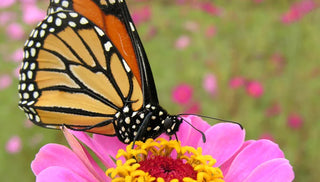 A monarch caterpillar and chrysalis on milkweed plant.
A monarch caterpillar and chrysalis on milkweed plant.Incredible. That's the word that comes to mind when I think about the monarch butterfly. An insect with a body the size and weight of a paper clip can migrate hundreds of miles or more, with successive generations navigating the 1,500+ miles from the US and Canada to overwintering sites in central Mexico.
These miraculous creatures are in trouble. Though monarch populations have been declining during the past decade, they've seen sharp declines in the last few years. Scientists now believe this is a long-term trend, rather than a short-term phenomenon caused by specific weather events, such as drought or hurricanes. What can gardeners do to help?
1. Create a Welcoming Habitat
Though you can't single-handedly bring back the monarchs, you can make your landscape friendly to monarchs throughout their lifecycle by creating an inviting place to lay eggs, sip nectar, and find shelter on a chilly evening.
Grow caterpillar plants. Monarch caterpillars are fussy eaters. Adults lay eggs only on milkweed (Asclepias species), because that's the only plant the caterpillars will eat. No milkweed, no monarchs. Although there are over 100 species of milkweed, some of the most widely adapted and readily available include common milkweed (Asclepias syriaca, a favorite of monarchs), swamp milkweed (A. incarnata, which thrives in moist soil) and butterfly milkweed (A. tuberosa, which prefers well-drained soil).
 Common milkweed (Asclepias syriaca), swamp milkweed (Asclepias incarnata), and butterfly milkweed (Asclepias tuberosa). Photos: AmericanMeadows.com
Common milkweed (Asclepias syriaca), swamp milkweed (Asclepias incarnata), and butterfly milkweed (Asclepias tuberosa). Photos: AmericanMeadows.comGrow nectar plants. Adult monarchs must get all their energy by sipping nectar. Plants in the sunflower family, which includes asters, black-eyed Susans, calendula, coreopsis, purple coneflowers and zinnias, are particularly nectar-rich. Look for single varieties whose flowers consist of a ring or two of petals surrounding a central disk, rather than double varieties, whose blooms are filled with petals and lack a central disk. Singles tend to have more nectar.
Complete the habitat. Butterflies need a landing pad to drink and they love mud puddles. Create a few shallow divots in bare soil and keep them moist, so butterflies can sip water and get much-needed minerals from the soil. Plant trees and shrubs where butterflies can roost at night. Butterflies can't fly when they're cold, so place large, flat rocks in locations that receive morning sun to give them a place to warm up.
Certify your backyard as a Monarch Waystation. Contribute to monarch conservation by joining thousands of people who have created these certified monarch habitats in home gardens, at schools and businesses, and along roadways. Monarch Waystations provide the food and shelter that monarchs need to live, reproduce and sustain their migration. Encourage your neighbors to do the same.
 A monarch butterfly on sunflower. Photo: Suzanne DeJohn
A monarch butterfly on sunflower. Photo: Suzanne DeJohn2. Use Pesticides with Care
The pristine lawns and landscapes that many have come to associate with a well-tended home have come at a cost: A surprising amount of pesticides are used to maintain them. As a nation, we need to reconsider our definition of a well-maintained yard and allow a few (nectar-rich) dandelions and other "imperfections." Here are some ways you can minimize the use of pesticides.
Identify pests before treating. Just because you see an insect near a chewed leaf, don't assume it's the culprit. Always identify what is causing the damage before spraying any pesticides — even organic ones. Remember that about 95 percent of the insects you see in your garden are either helpful or harmless!
Encourage natural controls. Birds and beneficial insects can go a long way toward maintaining balance in your landscape. Create a welcoming habitat with feeders and shelters.
Tolerate some damage. Keep in mind that caterpillars are butterfly and moth larvae. Overlook some feeding damage on plants as part of the process in creating a welcoming butterfly habitat.
3. Act Locally, Act Globally
Advocate for monarchs in your community. Your local wildflower society, state native plant society, garden club or Master Gardeners may offer opportunities to advocate for monarchs and to create Monarch Waystations in community gardens, parks and along roadsides.
Join a citizen scientist project. Citizen science is the collection of scientific data by individuals who are not professional scientists. For example, participants in the Monarch Larva Monitoring Project collect data on monarch larva populations and milkweed habitat to help scientists better understand how monarch populations vary over time and location. Journey North citizen scientists track monarch migration and report their observations to real-time maps.
Get involved in the state/national/international campaign to save monarchs. The plight of the monarch is making headlines, as scientists, agriculture experts and policy-makers struggle to come up with a solution to this complex problem. Deforestation in their overwintering grounds in Mexico has long been blamed. However, research is now showing that the widespread planting of genetically engineered, herbicide-resistant corn and soybeans in the Midwest and the associated huge increase in herbicide spraying has killed off the native milkweed historically found in abundance in and around farmers' fields, removing a tremendous amount of monarch habitat. Therefore, agricultural practices can potentially play a huge role in reinvigorating monarch populations. When farm policy is being debated, make your voice heard by contacting your state and national representatives. Consider joining an advocacy group, such as Monarch Watch.
Learn and share. From egg to larva to pupa to adult, butterfly metamorphosis has captured the hearts of poets and writers. And scientists still don't understand the marvel of monarch migration how successive generations of butterflies are able to navigate to a place they've never been before. Consider volunteering to make presentations about these fascinating creatures to local school and community groups. You'll be helping children and adults make a stronger connection to nature, and show them ways they, too, can help save the monarch butterfly before it's too late.





